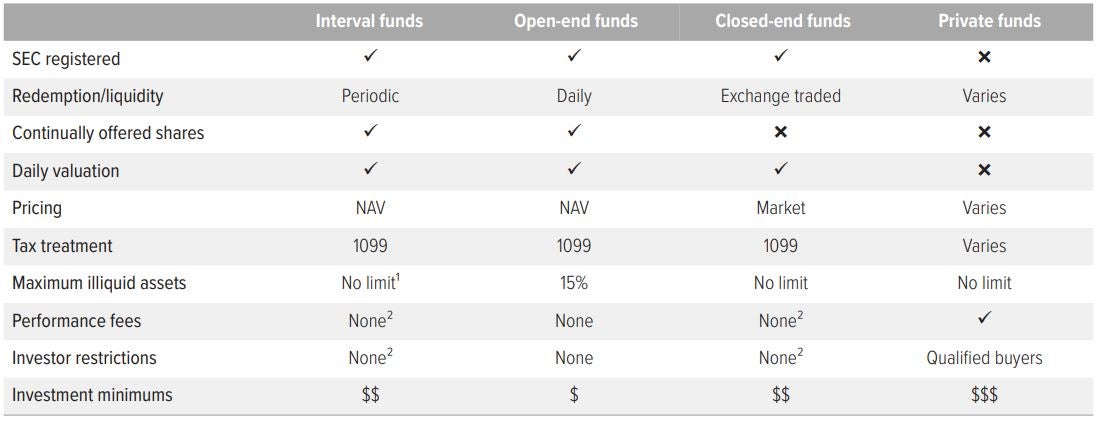
Interval funds may provide access to potentially higher-yielding, less-liquid securities while also offering periodic liquidity, giving investors more control over how they manage their assets. Here’s what you need to know.
What are interval funds?
Interval funds are continuously offered, SEC-registered funds that offer to repurchase a certain number of shares at monthly or quarterly intervals (hence the name). Technically considered closed-end funds under the Investment Company Act of 1940, interval funds combine aspects of both open-end and closed-end funds, providing access to less-liquid securities that are usually reserved for institutional investors in private funds (Exhibit 1).

Source: Voya IM. ¹ Must maintain sufficient liquidity to meet repurchase offers. ² May vary by fund and share class.
How do redemptions work?
Investors may buy shares of an interval fund at any time based on the fund’s net asset value (NAV), which is printed daily. However, unlike traditional closed-end funds, interval funds do not trade on secondary markets such as listed securities exchanges. Instead, shareholders may sell shares through a redemption process.
At each interval period, interval funds must offer to repurchase a minimum of 5% of their total shares outstanding, although they may choose (at their discretion) to repurchase a greater amount. Shareholders are notified at least 21 days prior to the repurchase request deadline, during which time shareholders can submit their requests. If the total redemption requests exceed the offer amount, investor redemptions are granted on a pro rata basis.
What are the potential benefits?
Higher yields from less-liquid securities
Traditional open-end and closed-end funds are restricted from owning more than 15% of assets classified as illiquid, which can limit opportunities, especially in the securitized and leveraged credit arenas. By contrast, interval funds have no such limitation, giving portfolio managers the flexibility to construct portfolios of high-conviction ideas without liquidity constraints.
By widening the field of opportunities, interval funds may offer greater access to less-liquid securities that offer the potential for higher returns. (Investors typically demand higher yields in exchange for accepting less liquidity—a characteristic known as an “illiquidity premium.”) Private funds routinely access this premium for institutional clients and other qualified buyers. Interval funds bring this premium to individual investors, with lower investment minimums and without the complex tax forms, lengthy subscription agreements or performance fees associated with many private funds.
Portfolio diversification
Portfolios consisting of less-liquid securities may generate income from alternative sources than what are typically found in more liquid markets such as government and corporate bonds, stocks and cash. As a result, interval funds may pursue strategies that may be less correlated to other asset classes, which can improve risk-adjusted returns.
Lower interest-rate sensitivity
Although a bond’s maturity is generally the most significant factor in duration measurements, investments with higher yields will naturally have a lower duration, all else being equal. This is because the additional cash flow received from the higher coupon security make it generally less sensitive to changes in interest rates. In this manner, higher yields from less-liquid securities may provide an added cushion against interest-rate-related volatility.
Who should invest in interval funds?
An investment in interval funds may not be suitable for everyone. While the funds do offer periodic liquidity, it is prudent to consider them illiquid, as there is no guarantee that investors will be able to sell in a timely manner. However, investors with long-term investment horizons looking for opportunities to earn higher income from less liquid securities may find interval funds attractive.
A note about risk Although interval funds provide limited liquidity through periodic repurchase offers, investors should consider the funds to be an illiquid investment. There is no secondary market for interval funds, and none is expected to develop. Furthermore, unlike with open-end funds, which permit daily redemptions, investors cannot sell interval fund shares at any time of their choosing. Because of these factors, investments in interval funds are subject to liquidity risk, as an investor may not be able to sell their shares in a timely manner at an advantageous price. There is no guarantee that an investor will be able to tender all or any of their requested fund shares in a periodic repurchase offer. The NAV of an interval fund may be volatile, and a fund’s use of leverage will increase this volatility. |
